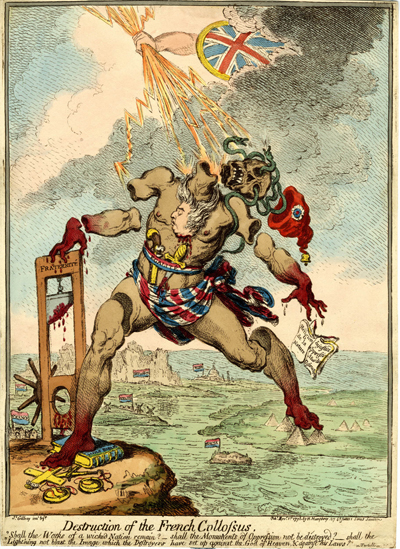Destruction of the French Collossus
This is one of seven prints created by Gillray in the wake of Horatio Nelson's resounding victory over the French fleet at the Battle of the Nile. But in this print, by far the most remarkable of the seven, Gillray uses caricature not to create an extreme though recognizable image of a real individual—a sans-culotte Fox, a manic Napoleon, a bottomless Pitt—but instead to imagine and personify the French Revolution itself at what he hopes is the beginning of its destruction.

© Trustees of the British Museum
In Gillray's imagining, the Revolution is a powerfully grotesque figure of death, decay, and destruction, a Collossus straddling most of Europe and the middle East, with one bloody foot planted in France where it all began and the other in Egypt (where Napoleon had just launched an ambitious campaign). Betweeen his collossal legs, we see French flags flying over the other territories that had been occupied by the revolutionaries in the intervening years, including Malta, Holland, Switzerland, and Rome. His right foot tramples upon the Christian cross, the Bible, and the scales of Justice while his right hand grips a bloody guillotine which had become a symbol of the reigning fraternity of death in France. His left hand has just dropped a book inscribed with the revolutionary substitutes for Bible and Justice: "Religion de la Nature" and " Injustice Oppression Murder Destruction."
Not suprisingly this grotesque monster is portrayed with all the familiar symbols of French Republicanism. He is, of course, a sans-culotte wearing a tri-colored loin cloth instead of breeches, and falling from his head is the revolutionary bonnet-rouge/fool's cap that Gillray routinely gives to all French sympathizers. In his belt labeled "Egalité," this Collossus has both a flint-lock pistol and a bloody dagger, familiar to Gillray's audience ever since the famous "dagger scene" in the House of Commons in 1792. But around his neck, like the now proverbial albatross, is the severed head of the French King, Louis XVI.*
But perhaps the most striking feature of the print is the surreal image of the Revolution being dismembered right before our eyes, with the severed body parts hanging impossibly in mid-air like a Dali painting. The Biblical sounding quotation attributed to Tertullian on the print asks
Shall the Works of a wicked Nation remain?__shall the Monuments of Oppression not be destroyed?__ Shall the Light'ning not blast the Image, which the Destroyers have set up against the God of Heaven, & against his Laws
The answer is being given from on high by the fistful of Jove-like lightning bolts coming from a British arm emerging from the dark clouds. But, of course in the real world of 1798, defeating the French Collossus was not so easy. Nelson's victory gave Britain a reason to be proud, and that pride and exultation resulted in an amazing burst of creativity from Gillray as he met the pent up need to celebrate with print after print. But though the victory at the Battle of the Nile gave Britain effective control of the sea, the land war dragged on for almost another sixteen years.
* Our current expression "like an albtatross around one's neck" derives from "The Rime of the Ancient Mariner" written in 1797 and published in 1798 as part of The Lyrical Ballads. Whether Gillray knew the poem and intended that allusion is a matter for debate. But the conspicuousness of the severed head in the print reinforces what was certainly true—that the execution of the King was inescapably associated with the Revolution itself and was key to the way it would forever be perceived.
Sources and Reading
- Commentary from the British Museum on Destruction of the French Collossus.
- "Colossus of Rhodes," Wikipedia
- "Tertullian," Wikipedia
- Thomas Wright and R.H. Evans, Historical and Descriptive Account of the Caricatures of James Gillray #213
- Thomas Wright and Joseph Grego, The Works of James Gillray, the Caricaturist; With the History of His Life and Times pp. 248-9.
Comments & Corrections
NOTE: Comments and/or corrections are always appreciated. To make that easier, I have included a form below that you can use. I promise never to share any of the info provided without your express permission.